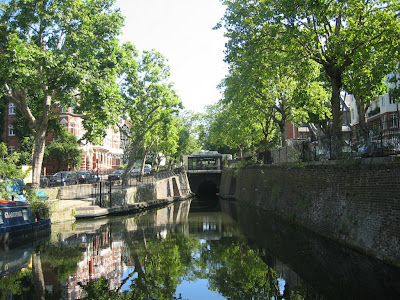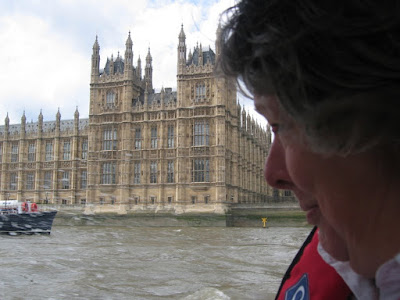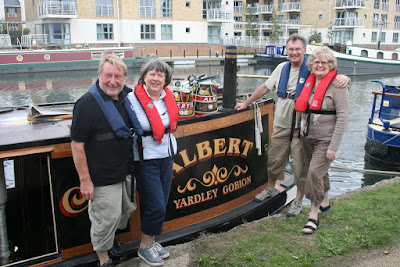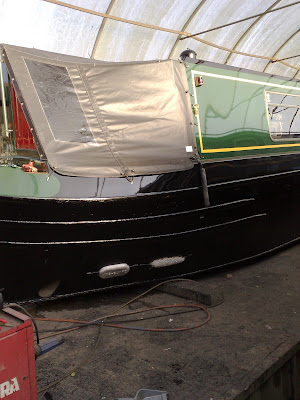Catching up on posts, bit of a delay but with good reasons.
On Friday (15/8) we left Little Venice visitor moorings and travelled down the Regents Canal to Limehouse.
 Approaching Maida Hill Tunnel
Approaching Maida Hill Tunnel
The trip through Regents Park in bright sunshine was delightful. When we reached the top of Camden Locks we found narrow boats Imagine and Soup Dragon using the right-hand lock so we took the left. It was interesting locking down side by side in two locks. There were lots of sightseers, almost like Stoke Bruerne Top Lock on a warm August Bank Holiday Monday.
We moored up for lunch just before Islington tunnel and were overtaken by Imagine and Soup Dragon. We followed them through the tunnel and met a boat waiting at the other end. Because it is a one-way passage tunnel they had to wait sometime for three boats to pass. Unfortunately, just as we left the tunnel another boat entered at the other end and therefore they had to wait even longer. The following boat turned out to be the community boat Pride of Sandwell. We met the boat, and her skipper, earlier in the year in Braunston when the boat was in transit from the West Midlands to London. We went down several locks with them. The kids on board were enjoying themselves and were generally well behaved. They turn off down the Hertford Union (Duckett’s Cut) to the River Lee. We carried on descending locks until we got to Limehouse Basin.
The basin looked great in the late afternoon sunshine. Several boats were moored up against the basin walls waiting to lock out onto the tidal Thames. We decided to go for the “posh” option and pay for a mooring on the floating pontoons. It was shortly after our arrival that our cruising plans changed dramatically. We discovered that we could accompany some of the crews going onto the Tideway and Maggie, who has always been reluctant to venture onto the Tideway, had to agree that this was a golden opportunity to travel through the heart of London by narrow boat. So instead of sampling the delights of the River Lee we chose to experience central London from the river! We negotiated with Imagine and Soup Dragon about forming a flotilla, and discussed our plans with the lockkeepers.
After preparing the boat (deploying the anchor, adjusting the ballast, checking the weed hatch, and sealing up the front door vents) we locked onto the Tideway at 11.30 on Saturday morning (16/8). However, before we left the marina were interviewed by the River Police in their counter terrorism role! The officers had appeared on the recent TV series and assured us that we didn’t look like terrorists and admired Albert’s interior. Leaving the lock onto the turbulent Thames was an experience, particularly as a high-speed catamaran just passed us as we left the cut. Michael with his mum as crew on Soup Dragon led the way. We followed, and Imagine with Nick and Sarah brought the rear. Soup Dragon, having a more powerful engine, was plainly faster than Albert with its Ruston 2YWM and Imagine with its
Gardner 2LW. We kept in touch by UHF radio which was invaluable. The general swell on the river was strong particularly along exposed reaches.
 Canary Wharf from the Tideway
Canary Wharf from the Tideway
It was elating to see Tower Bridge as we turned the curve at Wapping; surely this has to be the boating highlight. It was quite rough around Parliament with a fresh wind, lots of crossing river traffic and a strong incoming tide. We took as many pictures as we could but we had to be very aware of obeying the navigation rules and keeping a good watch on other traffic. At one point, Nick on Imagine had to navigate carefully to avoid a large trip boat that was trying to come alongside Westminster Pier. The views of
The London Eye, Parliament and Westminster Bridge were fantastic. Although our speed over the water was relatively modest the rate at which we passed under bridges clearly indicated how quickly we were travelling. Anne and Maggie who were sitting in the well deck occasionally got wet from spray as the bows pitched.
 Albert passing under Tower Bridge
Albert passing under Tower Bridge
 Choppy in the Westminster Reach
Choppy in the Westminster Reach
 Maggie getting splashed outside the Houses of Parliament
Maggie getting splashed outside the Houses of Parliament
After Battersea the river became calmer and boat traffic a lot less. We were particularly keen to photograph Albert approaching Albert Bridge. Michael came on the UHF radio and asked if Albert was glowing with pride as she passed underneath.
 Albert approaching Albert Bridge
Albert approaching Albert Bridge
Steve was particularly interested in the journey over the Tideway rowing course (
Varsity Boat Race) since he has rowed in the
Head of the River Races. By now we were travelling in bright sunshine on relatively calm water.
 Passing the rowing clubs at Putney
Passing the rowing clubs at Putney
We slowed down a little since Imagine and Soup Dragon were travelling up to Teddington through the Richmond Barrier and didn’t want to arrive at the barrier before it was raised. The calm of the water was disturbed when a cruiser, (Quakers Two) who had left Limehouse shortly after us, overtook us at Kew Bridge. Their wake was larger than nearly all the traffic we met in Central London.
We waved goodbye to Imagine & Soup Dragon and they carried on up to Teddington. We turned once more up the cut to Brentford and Thames Lock. We negotiated the low bridge at Brentford High Street and the Gauging Locks and moored up in the basin.
 The crew at Brentford
The crew at Brentford
With a feeling of elation we recounted tales of the trip all evening. What a wonderful journey! We are indebted to the crews of Imagine and Soup Dragon for letting us join them for this memorable trip.
We left Brentford Basin on Sunday (17/8)morning in sunshine and made our way up Hanwell Locks to Norwood. Initially we travelled with NB Mr Heron, but because other boats were moving up the flight it made more sense for them to pair up with another crew and we travelled up the main part of the flight alone. However, with a crew of four we made great progress and soon moved on to Bulls Bridge where we visited Tesco for provisions. We moored up for the night just below Cowley Lock.
















